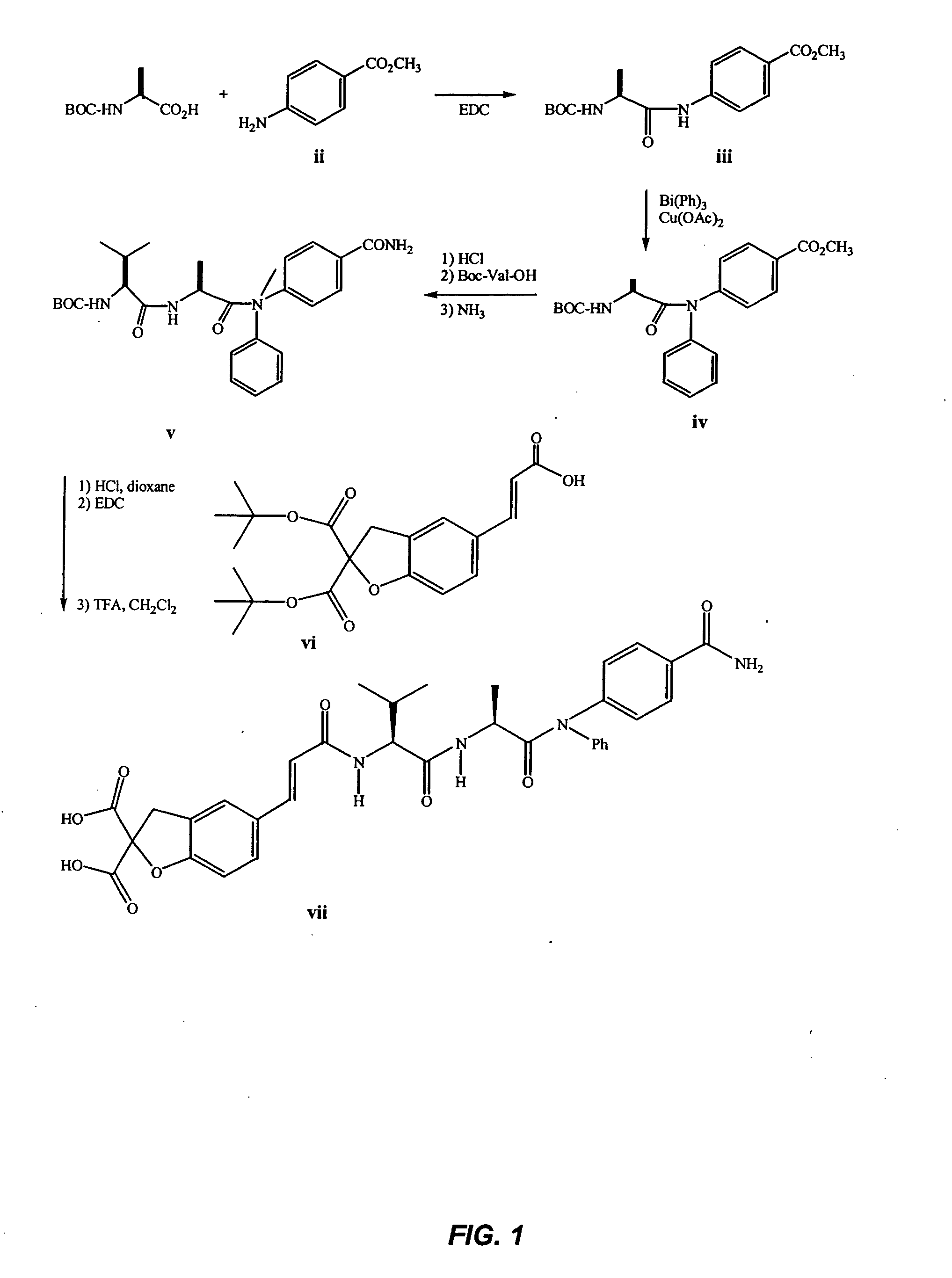STAT modulators
a stat4 and stat6-mediated signal transduction technology, applied in the field of compound and pharmaceutical compositions, can solve the problems of hampered identification of agents that can modulate stat4 and stat6-mediated signal transduction, undesirable side effects,
- Summary
- Abstract
- Description
- Claims
- Application Information
AI Technical Summary
Problems solved by technology
Method used
Image
Examples
example 1
[0099] This example illustrates the synthesis of compound 1.
Preparation of Compound 1.1
[0100] To a cooled (−78° C.) solution of tert-butyl methyl bromomalonate (10 g, 39.5 mmol) and 2-chloromethyl-4-bromophenol (8.75 g, 39.6 mmol) at −78° C. was added lithium bis(hexamethyldisilyl)amide (42 mL, 1.0 M in THF) dropwise. After 60 minutes at −78° C., the cooling bath was removed and the reaction mixture was allowed to warm to room temperature, diluted with saturated NH4Cl aqueous solution (200 mL). The phases were separated. The aqueous phase was extracted with Et2O (2×100 mL). The combined organic phases were dried over MgSO4, and concentrated in vacuo. The residue was purified by silica gel flash chromatography (EtOAc / hexanes) to afford 12 g (85 %) of white solid.
Preparation of Compound 1.2
[0101] To a solution of 1.1 (3.0 g, 8.4 mmol) and acrylic acid (3 mL, 43.8 mmol) in Et3N (10 mL) and toluene (15 mL) was added Pd(OAc)2 (0.56 g, 2.5 mmol) and tri-o-tolylphosphine (1.52 g, ...
example 2
[0110] This example illustrates the synthesis of compound 2.
Preparation of Compound 2.1
[0111] To a solution of di-tert-butyl bromomalonate (3 g, 10.2 mmol) and 5-bromosalicylaldehyde (2.25 g,, 11.1 mmol) in 2-butanone (18 mL) was added potassium carbonate (2.1 g, 15 mmol). The reaction mixture was stirred at refluxing temperature for 1 hr. The reaction was cooled to room temperature, diluted with water and the phases were separated. The aqueous phase was extracted with Et2O (3×100 mL). The combined organic phases were washed with brine (100 mL), dried over MgSO4, and concentrated in vacuo. The residue was purified by silica gel chromatography (EtOAc / hexanes) to afford 3.0 g (71%) of 2.1 as a clear oil.
Preparation of Compound 2.2
[0112] To a solution of tert-butyldimethylsilyl chloride (0.55 g, 3.6 mmol) and 2.1 (1 g, 2.4 mmol) in DMF (10 mL) was added imidazole (0.32 g, 4.8 mmol). The reaction mixture was stirred at room temperature for 48 hr. The reaction was diluted with E...
example 3
[0128]
Preparation of Compound 3.1
[0129] To a solution of 2-aminobenzyl alcohol (7.12 g, 58 mmol) in methylene chloride (200 mL) at −10° C., 2,4,4,6-tetrabromo-2,5-cyclohexadien-1-one (25 g, 61 mmol) was added in portions. During the addition, the temperature of the reaction mixture was maintained between −10° C. and 0° C. The reaction mixture was warmed up to room temperature and then extracted with 2 N sodium hydroxide solution (2×50 mL). The organic layer was washed with water and dried over MgSO4, filtered and concentrated in vacuo to afford 2-amino-5-bromobenzylalcohol as a yellow solid which was used without further purification.
[0130] To a solution of 2-amino-5-bromobenzylalcohol (6.81 g, 33.7 mmol) and NEt3 (6.63 mL, 47.2 mmol) in ethyl ether (120 mL) at 0° C., a solution of triflouroacetic anhydride (5.23 mL, 37 mmol) in ether (10 mL) was added dropwise. The mixture was then stirred at 0° C. for addition 1 hr. The reaction mixture was washed with 10% H2SO4 aqueous soluti...
PUM
| Property | Measurement | Unit |
|---|---|---|
| temperature | aaaaa | aaaaa |
| temperature | aaaaa | aaaaa |
| temperature | aaaaa | aaaaa |
Abstract
Description
Claims
Application Information
 Login to View More
Login to View More - R&D
- Intellectual Property
- Life Sciences
- Materials
- Tech Scout
- Unparalleled Data Quality
- Higher Quality Content
- 60% Fewer Hallucinations
Browse by: Latest US Patents, China's latest patents, Technical Efficacy Thesaurus, Application Domain, Technology Topic, Popular Technical Reports.
© 2025 PatSnap. All rights reserved.Legal|Privacy policy|Modern Slavery Act Transparency Statement|Sitemap|About US| Contact US: help@patsnap.com



